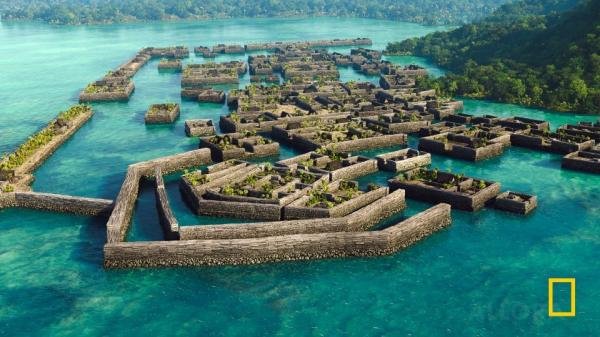Nan Madol, a captivating and enigmatic city, stands on the shores of Pohnpei in Micronesia. This ancient city, which dates back over 900 years, continues to astonish both historians and archaeologists due to its remarkable engineering and rich cultural significance. Once the ceremonial and political center of the Saudeleur Dynasty, Nan Madol’s construction remains shrouded in mystery, particularly regarding how its builders transported the massive basalt stones that form its artificial islets. Today, Nan Madol is an enduring testament to the ingenuity of ancient civilization and the many unexplained feats of engineering that still captivate the world.
The Construction of Nan Madol: A Marvel of Engineering
Built upon a series of artificial islets, Nan Madol is a striking architectural achievement. Its creators, the Saudeleur Dynasty, constructed the city using colossal basalt stones—some weighing as much as 50 tons. These stones, which are not native to the island, were transported from distant quarries, likely located on the main island of Pohnpei, and placed with incredible precision on the islets. The construction of Nan Madol is a feat of engineering that challenges modern understanding of ancient techniques.

Local Legends: Magic and Mystery Behind the Stones’ Transport
While the precise methods used to transport these massive stones remain unknown, local legends provide a fascinating explanation. According to folklore, the Saudeleur people used sorcery to move the heavy basalt blocks across the water. The stories claim that powerful magic was employed to make the colossal stones float, allowing them to be placed with extraordinary accuracy on the artificial islets. This belief in sorcery reflects the mystical aura surrounding Nan Madol and hints at how deeply these ancient people were intertwined with spiritual beliefs.

These legends highlight the awe-inspiring nature of the construction process. They also underscore the mystery that has surrounded Nan Madol for centuries. How could the builders of this ancient city move such massive stones without modern tools or technology? Despite the fantastical nature of these legends, they continue to fuel the intrigue and wonder surrounding the city.
Modern Theories: How Were the Stones Transported?
Scholars have long debated how the Saudeleur people transported these massive stones. Several theories have been proposed, although no single one has been conclusively proven. One theory suggests that large rafts were used to carry the stones across the water. This theory is supported by the idea that the people of Nan Madol were skilled seafarers, capable of navigating the open ocean and carrying heavy cargo.

Another theory posits that wooden sleds and leverage systems might have been employed to move the stones on land before they were loaded onto rafts or barges. Some researchers have also speculated that ropes and pulleys were used to move the stones into place once they reached the islets. While these ideas are plausible, no direct evidence has been found to confirm any of these methods.
What remains most fascinating is the precision with which the stones were placed. The alignment of these massive blocks on the artificial islets demonstrates an advanced understanding of engineering and spatial design that continues to elude modern researchers.
Nan Madol: A Testament to Ancient Ingenuity
Despite the lack of definitive answers, Nan Madol remains a remarkable example of ancient engineering. Its construction methods, whether achieved through advanced technology, seafaring expertise, or even the mystical practices described in local legends, reflect the ingenuity and resourcefulness of the Saudeleur people. The city’s strategic design, which once served as a political and ceremonial hub, speaks to the importance of architecture and urban planning in ancient Micronesian culture.

Today, the ruins of Nan Madol continue to stand as a testament to the extraordinary skills of the people who built them. The combination of massive basalt blocks, precise construction, and the enduring mysteries of how it was all achieved makes Nan Madol one of the most fascinating archaeological sites in the world.
The Enduring Mystery of Nan Madol
The legacy of Nan Madol is one of mystery and wonder. The city’s impressive ruins, coupled with the fantastical tales of sorcery and advanced construction methods, ensure that Nan Madol will remain an enduring subject of fascination for generations to come. As researchers continue to study its origins and construction techniques, the city will undoubtedly continue to reveal new insights into the ancient world. Whether through the lens of modern science or ancient legend, Nan Madol stands as a remarkable monument to the ingenuity, skill, and mystery of one of the world’s most intriguing ancient civilizations.

